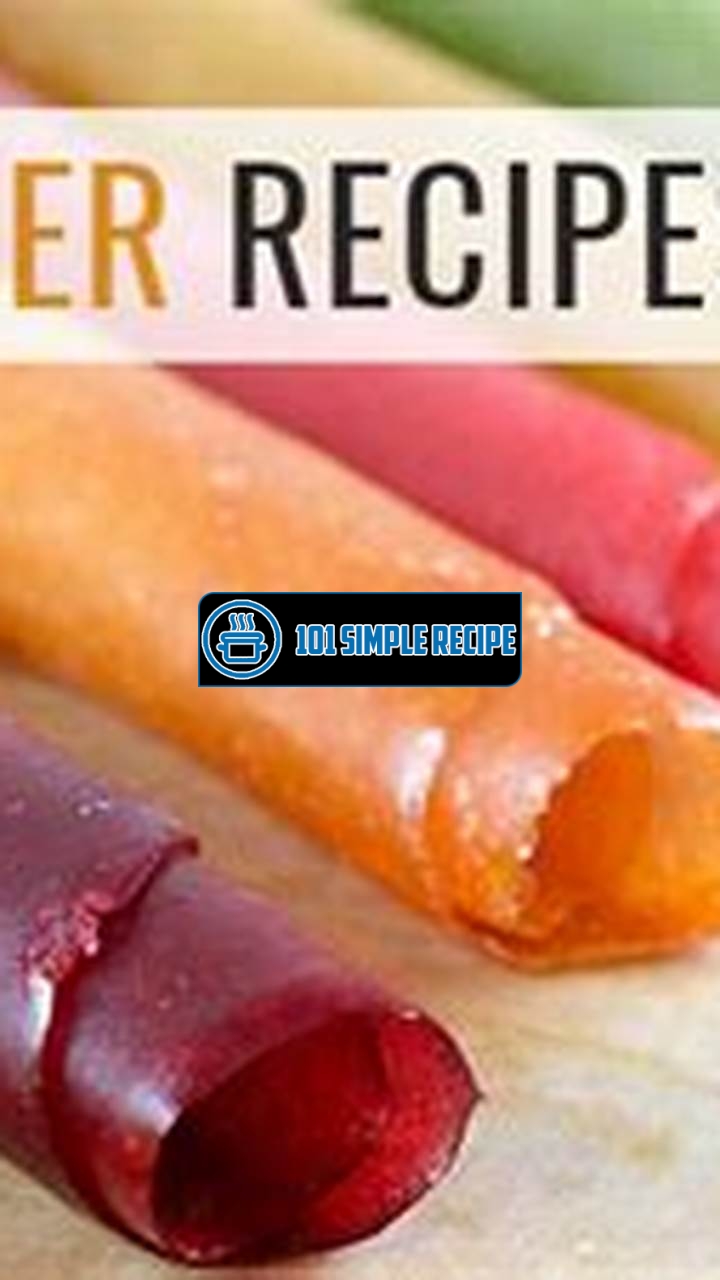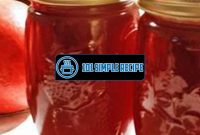Are you looking for a delicious and healthy snack option? Look no further! We have a mouthwatering homemade fruit leather recipe that will satisfy your taste buds and provide essential nutrients. Whether you are trying to incorporate more fruits into your diet or need a tasty treat for your little ones, this recipe is a game-changer. Made with all-natural ingredients and bursting with flavors, this fruit leather will make you forget about those store-bought snacks. So, put on your chef hat and let’s dive into the world of homemade goodness.

The History of Fruit Leather
Discover the origins and evolution of fruit leather as a homemade snack.
Ancient Roots of Fruit Leather
In ancient times, our ancestors found ingenious ways to preserve food. Fruit leather, also known as fruit roll-ups, is believed to have originated thousands of years ago.
Ancient civilizations, such as the Egyptians and Mesopotamians, used the sun and dry desert air to dry fruits to extend their shelf life. They discovered that by drying fruits under the scorching sun, the moisture content was reduced, making the fruits last longer.
The practice of drying fruits eventually evolved into the creation of fruity, chewy treats that were easy to store and transport. Ancient cultures would mash or puree fruits, spread the mixture onto flat surfaces, and let them dry in the sun. This process resulted in a delectable, portable snack that could be enjoyed throughout the year.
The Rise of Modern Fruit Leather
As time progressed, advancements in technology transformed the production of fruit leather. The advent of the industrial revolution brought about new methods for manufacturing this delightful snack.
With the introduction of commercial food processing equipment, fruit leather production became more efficient and widespread. Companies began producing fruit leather on a larger scale, making it readily available to the masses. The increased accessibility led to fruit leather becoming a popular choice for a quick and healthy snack.
Manufacturers also started experimenting with different fruits and flavors, adding variety and excitement to this timeless treat. From classic flavors like strawberry and apple to unique blends like mango-pineapple, there was a fruit leather to suit every palate.
Fruit Leather Today: Health and Sustainability
In recent years, fruit leather has experienced a resurgence in popularity, thanks to its natural ingredients and health benefits.
Unlike many processed snacks on the market, homemade fruit leather contains no artificial preservatives, colors, or flavors. It’s a guilt-free alternative to satisfy those cravings for something sweet. The minimal processing ensures that the nutritional value of the fruit remains intact.
Furthermore, fruit leather supports sustainable practices. It can be made using overripe or excess fruits that might otherwise go to waste. By transforming these fruits into a shelf-stable snack, we can reduce food waste and make a positive impact on the environment.
Today, you can find fruit leather in health food stores, farmers’ markets, and even make your own at home. With its rich history and a timeless appeal, fruit leather continues to delight snack enthusiasts of all ages.
If you’re looking to incorporate a healthy option into your fruit leather recipe, check out this Weight Loss Recipe. It’s packed with nutritious ingredients and is perfect for those watching their waistline.
Benefits of Making Fruit Leather at Home
When it comes to snacking, fruit leather is a delicious and nutritious option that satisfies your cravings without compromising your health. Instead of buying pre-packaged fruit leather from the store, why not consider making your own at home? Not only does this give you control over the ingredients and nutrition, but it also allows for creative flavor combinations and proves to be cost-effective while reducing waste. Let’s explore these advantages in detail.
Control Over Ingredients and Nutrition
Making fruit leather at home gives you complete control over the ingredients that go into it, allowing you to prioritize your health and well-being. Unlike store-bought options, homemade fruit leather eliminates the need for artificial additives, preservatives, and excessive sweeteners. You have the freedom to choose fresh and organic fruits, ensuring that your snack is packed with essential vitamins, minerals, and antioxidants.
By making your own fruit leather, you can create a healthier alternative without compromising on taste or quality.
Creative Flavor Combinations
One of the most exciting aspects of making fruit leather at home is the opportunity to experiment with creative flavor combinations. While pre-packaged fruit leathers often stick to traditional flavors, such as strawberry or apple, when you make your own, you can let your imagination run wild. Blend different fruits together, such as mango and pineapple or raspberry and peach, to create unique and delicious fruit leather that matches your taste preferences.
The possibilities for flavor combinations are endless, ensuring that each batch of homemade fruit leather is a delightful surprise.
Cost-Effectiveness and Reduced Waste
Creating fruit leather at home proves to be not only cost-effective but also contributes to reducing waste. Store-bought fruit leathers can be expensive, especially if you consume them regularly. However, by making your own, you can save money by buying fruits in bulk or utilizing seasonal produce. Additionally, making fruit leather at home allows you to reduce packaging waste by using reusable silicone baking mats or parchment paper instead of individually wrapped pieces.
♻️ By choosing homemade fruit leather, you are not only saving money but also making an eco-friendly choice by minimizing waste.
In conclusion, making your own fruit leather at home comes with numerous benefits. From having control over ingredients and nutrition, to indulging in creative flavor combinations and being mindful of cost-effectiveness and waste reduction, homemade fruit leather ticks all the boxes for a healthy and delicious snack option. So, why not give it a try and enjoy the goodness of homemade fruit leather today?
Want to add a refreshing twist to your fruit leather recipe? Try this Punch Bowl Recipe for a burst of flavor. It’s the perfect snack for any occasion.
Essential Equipment and Ingredients
When it comes to making delicious homemade fruit leather, having the right tools and ingredients is crucial. Let’s take a detailed look at what you’ll need to create the perfect fruit leather snack.
Blender or Food Processor
An essential piece of equipment you’ll need for creating fruit leather is a blender or food processor. These appliances will help you puree the fruits into a smooth consistency, ensuring a uniform texture in your fruit leather. Whether you choose a blender or a food processor, make sure it is capable of handling both soft and hard fruits.
Important: Ensure that your blender or food processor is clean and in good working condition to avoid any unwanted flavors or textures in your fruit leather.
Quality Fruits and Sweeteners
The quality of the fruits you choose for your fruit leather is paramount. Select fresh, ripe fruits that are at their peak of sweetness and flavor. This will ensure that your fruit leather is bursting with natural goodness.
Important: Choose a variety of fruits to create a unique flavor profile in your fruit leather. You can combine fruits like strawberries, raspberries, apples, and bananas to create a delicious blend of flavors. Experiment with different combinations to find your favorite.
Optional: If you prefer your fruit leather to be sweeter, you can add a natural sweetener like honey or maple syrup. This will enhance the sweetness of the fruits without adding any artificial ingredients.
Optional Additions for Texture and Flavor
While fruit leather is delicious on its own, you can also add optional ingredients to enhance its texture and flavor. Here are some ideas to consider:
- Spices and Herbs: Add a touch of warmth and complexity to your fruit leather by incorporating spices like cinnamon, nutmeg, or cardamom. You can also experiment with herbs such as mint or basil for a refreshing twist.
- Nuts and Seeds: For added crunch and nutrition, sprinkle some chopped nuts or seeds onto the fruit puree before drying. Almonds, walnuts, chia seeds, or flaxseeds are all great options to consider.
- Citrus Zest: For a burst of citrusy goodness, add some grated lemon, lime, or orange zest to the fruit puree. This will lend a bright and zesty flavor to your fruit leather.
- Coconut: If you love the tropical flavor of coconut, sprinkle some shredded coconut onto the fruit puree before drying. It will add a hint of sweetness and a delightful texture to your fruit leather.
Note: Feel free to get creative with your fruit leather recipe and try different combinations of ingredients. This will allow you to personalize the flavors and textures to suit your taste preferences.
By having the essential equipment and selecting high-quality ingredients, you’ll be well on your way to creating a healthy and delicious homemade fruit leather. Enjoy this wholesome snack on its own or take it on the go for a convenient burst of fruity goodness!
Step-by-Step Guide to Making Fruit Leather
Follow a comprehensive tutorial that outlines the entire process of crafting homemade fruit leather.
Preparing the Fruit
Before you can start making delicious homemade fruit leather, you need to prepare the fruit. Choose your favorite fruit or a combination of different fruits. Wash the fruit thoroughly, removing any dirt or pesticides. Then, peel the fruit and remove the seeds or pits if necessary. Chop the fruit into small pieces and place them in a blender or food processor.
Tip: Use ripe and juicy fruits for the best flavor and texture.
Blending and Sweetening
Once you have the fruit ready in the blender, it’s time to blend it until smooth. Start by pulsing the blender a few times to break down the fruit into smaller chunks. Then, blend on high speed until you achieve a smooth puree. If your fruit is particularly thick, you can add a small amount of water or fruit juice to help with the blending process.
Tip: If you prefer your fruit leather to be sweeter, you can add a natural sweetener like honey, maple syrup, or agave nectar. Start with a small amount and taste as you go until you reach your desired level of sweetness.
Dehydrating and Drying Techniques
Now that you have your fruit puree ready, it’s time to dehydrate and dry it to create the fruit leather. There are a few different techniques you can use to achieve the perfect texture and consistency.
One option is to use a food dehydrator. Spread the fruit puree evenly onto a dehydrator tray lined with parchment paper or a silicone mat. Set the dehydrator to a low temperature, around 135°F (57°C), and let it dry for 8-12 hours. Check the fruit leather occasionally to ensure it’s drying evenly.
Alternatively, you can use an oven to dry the fruit puree. Line a baking sheet with parchment paper and spread a thin layer of the puree on top. Set the oven to its lowest temperature, typically around 170°F (77°C), and bake for 4-6 hours. Keep an eye on the fruit leather to prevent it from burning.
Tip: If you prefer a chewier texture, you can leave the fruit leather slightly tacky instead of fully dried.
Once the fruit leather is dry and leathery to the touch, remove it from the dehydrator or oven. Let it cool completely before cutting it into strips or shapes of your choice. Roll each piece in parchment paper and store in an airtight container to maintain freshness.
Tip: Experiment with different fruit combinations and flavors to create your own unique fruit leather recipes.
Enjoy your homemade fruit leather as a healthy snack or take it on-the-go for a burst of fruity goodness throughout the day!
Troubleshooting and Storage Tips
When making delicious homemade fruit leather, it’s important to know how to overcome common challenges and keep your fruity treats fresh and delicious. Below are some troubleshooting and storage tips to help you enjoy the perfect fruit leather every time.
Preventing Stickiness and Brittleness
No one likes a fruit leather that’s too sticky or brittle. To prevent these issues, there are a few things you can do.
- Prepare the fruit properly: Before making your fruit leather, ensure that the fruits are properly washed, peeled, and pitted. If you’re using berries, make sure to remove any stems or leaves.
- Add natural thickeners: Some fruits are naturally high in water content, which can lead to a sticky fruit leather. To prevent this, you can add natural thickeners like applesauce or mashed bananas. These will not only improve the texture but also add a natural sweetness to your fruit leather.
- Spread the mixture evenly: When spreading the fruit mixture onto your drying trays, make sure to spread it evenly. This will ensure that the fruit leather dries evenly, reducing the chances of stickiness or brittleness.
- Monitor the drying time: Over-drying can make your fruit leather brittle, while under-drying can result in stickiness. It’s essential to monitor the drying time and remove the fruit leather from the dehydrator or oven when it is still slightly tacky to the touch. This will give you the perfect texture.
Note: By following these tips, you can prevent stickiness and brittleness in your homemade fruit leather and enjoy a tasty and satisfying snack.
Storage Methods for Longevity
Proper storage is essential to maintain the freshness and longevity of your homemade fruit leather. Here are a few storage methods to keep in mind:
- Wrap individually in parchment paper: After your fruit leather has dried completely, cut it into desired shapes and sizes. Wrap each piece individually in parchment paper before storing it in an airtight container or resealable bags. This will prevent the fruit leather from sticking together and maintain its texture.
- Store in a cool, dry place: To extend the shelf life of your fruit leather, store it in a cool, dry place. Avoid exposing it to direct sunlight or high humidity, as this can cause spoilage.
- Freeze for long-term storage: If you want to store your fruit leather for an extended period, you can freeze it. Place the wrapped pieces in a freezer-safe bag and remove as needed. Frozen fruit leather can last for several months.
Note: By following these storage methods, you can ensure the longevity and freshness of your homemade fruit leather, allowing you to enjoy it whenever the craving strikes.
Reviving and Salvaging Overly Dry Fruit Leather
If you happen to over-dry your fruit leather and it becomes too dry and brittle, don’t worry! There are a couple of ways you can revive and salvage it:
- Rehydrate with water: One method to revive overly dry fruit leather is by rehydrating it with water. Simply dampen a clean kitchen towel or paper towel, place it over the fruit leather, and let it sit for a few hours. The moisture from the towel will help soften the fruit leather.
- Add moisture-rich ingredients: Another option is to add moisture-rich ingredients to the dry fruit leather. You can spread a thin layer of nut butter, yogurt, or even honey on the surface of the fruit leather to improve its texture and taste.
Note: These methods can help salvage overly dry fruit leather and restore its chewiness and flavor, giving you a tasty snack once again.
For a delicious fruit leather recipe, try this White Castle Recipe. It’s a unique twist on traditional fruit leather that you and your family will love.
Thank you for reading this article about fruit leather recipes. We hope you found it helpful and inspiring to create your own homemade fruit leather. Remember, fruit leather is a fun and healthy snack that you can enjoy with your family and friends. If you have any questions or suggestions, please feel free to leave them in the comments section below. We appreciate your support and look forward to seeing you again soon!
Frequently Asked Questions
Here are some frequently asked questions about fruit leather recipes:
| No. | Questions | Answers |
|---|---|---|
| 1. | Can I use frozen fruits for making fruit leather? | Absolutely! You can use frozen fruits to make fruit leather. Just make sure to thaw them before blending. |
| 2. | How long does it take to dry fruit leather? | The drying time can vary depending on the thickness of the fruit puree and the humidity in your area. On average, it takes around 6 to 8 hours. |
| 3. | Can I add sweeteners to fruit leather? | Yes, you can add sweeteners like honey or maple syrup to enhance the taste of your fruit leather. Just adjust the amount according to your preference. |
| 4. | How long can I store fruit leather? | Properly stored fruit leather can last for several months. Make sure to keep it in an airtight container in a cool, dry place. |
| 5. | Can I use a dehydrator instead of an oven? | Yes, using a dehydrator is a great option for making fruit leather. Just follow the manufacturer’s instructions for drying time and temperature. |
| 6. | What are some creative flavor combinations for fruit leather? | You can try mixing different fruits together to create unique flavor combinations. Some popular options include strawberry-banana, mango-pineapple, and apple-cinnamon. |
Thank You for Reading!
We hope you enjoyed learning about fruit leather recipes and are excited to try making your own at home. Remember to experiment with different fruits and flavors to personalize your fruit leather. Don’t forget to share your creations with us by tagging us on social media. We appreciate your support and encourage you to visit our website again for more delicious recipes and cooking tips. Happy snacking!
Jump to Recipe
Fruit Leather Recipe

Learn how to make delicious fruit leather at home with this easy recipe. Perfect for a healthy snack on the go!
- 4 cups of fresh or frozen mixed berries
- 2 tablespoons of honey
- 1 tablespoon of lemon juice
- Preheat your oven to 170°F (75°C). Line a baking sheet with parchment paper.
- In a blender or food processor, combine the mixed berries, honey, and lemon juice. Blend until smooth.
- Pour the fruit puree onto the prepared baking sheet. Use a spatula to spread it evenly, about 1/4-inch thick.
- Bake in the preheated oven for 6 to 8 hours, or until the fruit leather is no longer sticky to the touch.
- Remove from the oven and let cool completely. Cut into strips or desired shapes, then roll them up.
- Store the fruit leather in an airtight container in a cool, dry place for up to several months.






